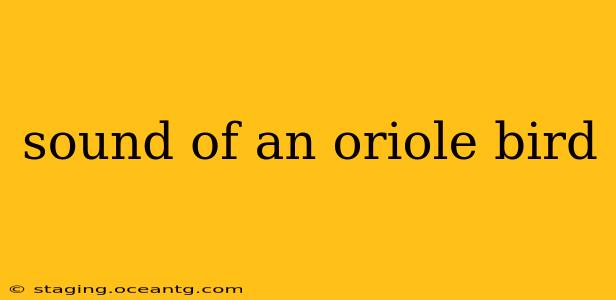Orioles, with their vibrant plumage and acrobatic feeding habits, are captivating birds. But their beauty is only half the story. Their vocalizations are just as striking, contributing significantly to their charm and making them easily identifiable to keen birdwatchers. This guide delves into the diverse sounds of orioles, exploring their songs, calls, and the factors influencing their vocalizations.
What does an oriole sound like?
This is the most common question regarding orioles' sounds. The answer isn't simple, as different oriole species produce different sounds, and even within a species, there's variation. Generally, oriole songs are described as being melodious, flute-like whistles and warbles, often containing a range of pitches and complex phrases. They're typically richer and more varied than the calls. Think of a bright, cheerful melody, sometimes with a slightly melancholic undertone depending on the context. Some species' songs are more complex and longer than others. They are often heard during breeding season, as a territorial defense and mate attraction strategy.
What are the different types of oriole calls?
Beyond their elaborate songs, orioles also use various calls for different communication needs. These calls are usually shorter and simpler than their songs, often sharp, chittering sounds or short whistles. These calls serve several purposes:
- Alarm calls: These are typically harsh, high-pitched sounds used to alert other orioles to potential danger.
- Contact calls: These softer, shorter calls are used to maintain contact between mates or within a flock.
- Begging calls: Young orioles use these calls to solicit food from their parents. These tend to be high-pitched and insistent.
How do I identify an oriole by its sound?
Identifying an oriole solely by its sound requires experience and familiarity with the vocalizations of different species in your region. However, paying attention to the characteristics mentioned above—the melodious nature of the song, the presence of whistles and warbles, and the shorter, simpler nature of calls—can be helpful. Listening to recordings of different oriole species can also aid in identification. Combining sound identification with visual observation (if possible) provides the most reliable identification.
What factors affect an oriole's song?
Several factors influence the specific sounds an oriole produces:
- Species: Different oriole species have distinct songs and calls. The Baltimore Oriole's song is markedly different from that of the Bullock's Oriole, for example.
- Individual variation: Even within the same species, individual birds will have slightly different songs and call variations. Think of it like human accents; while still recognizable as English, there are subtle nuances that distinguish them.
- Geographic location: Slight variations in song can occur across different geographic regions within a species' range.
- Context: The situation dictates the type of vocalization. A bird singing to attract a mate will produce a different sound than one warning of a predator.
Why do orioles sing?
The primary reasons for oriole vocalizations are:
- Territorial defense: Songs serve to advertise territory and warn off rival males.
- Mate attraction: Melodious songs attract females, playing a vital role in mate selection.
- Communication within the family unit: Calls aid in maintaining contact and coordinating activities within a family group.
Where can I hear oriole sounds?
The best place to hear oriole sounds is in their natural habitat! Visiting parks, gardens, or woodlands with suitable oriole habitat during their breeding season offers the best chance of experiencing these beautiful sounds firsthand. Online resources such as the Cornell Lab of Ornithology's Macaulay Library offer recordings of oriole songs and calls from various species.
This comprehensive guide offers a deeper understanding of the fascinating world of oriole sounds. By understanding the nuances of their vocalizations, we can further appreciate these striking and melodious birds. Remember, continued observation and listening are crucial for developing a keen ear for identifying the unique sounds of different oriole species.
